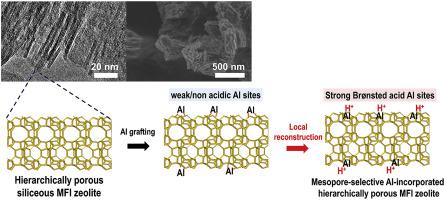Microporous and Mesoporous Materials ( IF 5.2 ) Pub Date : 2020-05-27 , DOI: 10.1016/j.micromeso.2020.110353 Wookdong Kim , Jeong-Chul Kim , Seungjun Lee , Jaeheon Kim , Ryong Ryoo

|
Post-synthetic Al grafting onto the surface silanols in mesoporous MFI zeolite has been investigated in an attempt to obtain a model catalytic material that possesses strong Brønsted acid sites at mesopore surfaces of the zeolite, but not inside the microporous framework. To this end, a siliceous MFI zeolite with a mesopore/micropore hierarchy was synthesized using a meso-micro dual structure-directing diammonium surfactant. The hierarchically porous zeolite was treated with anhydrous AlCl3 for the formation of Si–O–Al bonding with silanols on the mesopore surfaces. According to solid-state 31P NMR spectroscopy of the surface-adsorbed phosphine oxides and catalytic activity for decalin cracking, the Al-grafting treatment performed in the conventional manner resulted in the formation of weak Brønsted acid sites, similar to Al grafting on SBA-15 mesoporous silica. To obtain strong Brønsted acid sites, we have developed a method of heating the AlCl3-grafted zeolite in a controlled-humidity chamber before calcination. The resultant zeolite was catalytically active for cracking of hydrocarbons requiring strong acid sites, but not for methanol-to-hydrocarbon conversion. The results support that the moisture treatment caused a local reconstruction of the initially grafted Al–O–Si framework portion to a strong Brønsted acid site. In addition, our model catalytic zeolite material unveiled the catalytic activity of Brønsted acid sites at the mesopore surfaces in hierarchically porous zeolite in n-octane cracking. Furthermore, we confirmed that this method was effective for other mesoporous MFI zeolites obtained through a post-synthetic desilication route.
中文翻译:

通过铝接枝在分级多孔硅质MFI沸石上的中孔选择性结合强布朗斯台德酸催化位
已经研究了合成后的Al接枝到介孔MFI沸石的表面硅烷醇中,以尝试获得一种模型催化材料,该材料在沸石的介孔表面具有强布朗斯台德酸位,但在微孔骨架内部不具有。为此,使用介孔-微双重结构导向的二铵表面活性剂合成了具有介孔/微孔层次的硅质MFI沸石。用无水AlCl 3处理分层的多孔沸石,以在中孔表面上形成与硅烷醇的Si-O-Al键。根据固态31表面吸附的氧化膦的P NMR光谱和十氢化萘裂化的催化活性,以常规方式进行的Al接枝处理导致形成弱的布朗斯台德酸位,类似于在SBA-15中孔二氧化硅上接枝Al。为了获得强布朗斯台德酸位点,我们开发了一种加热AlCl 3的方法煅烧之前,将其在恒温恒湿室中接枝沸石。所得的沸石对于需要强酸位点的烃的裂解具有催化活性,但对于甲醇到烃的转化则没有催化活性。结果表明,湿气处理将最初接枝的Al–O–Si骨架部分局部重建为强布朗斯台德酸位。此外,我们的模型催化沸石材料揭示了正辛烷裂解中分层多孔沸石中孔表面的布朗斯台德酸位的催化活性。此外,我们证实该方法对通过合成后的脱硅途径获得的其他中孔MFI沸石有效。


























 京公网安备 11010802027423号
京公网安备 11010802027423号